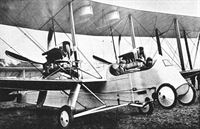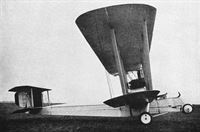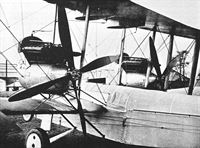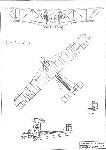P.Hare Royal Aircraft Factory (Putnam)
F.E.4
In mid-1915 a team led by S J Waters and Henry Folland undertook the design of a twin-engined pusher biplane designated F.E.4, the basic layout of which was based upon the results of windtunnel tests intended to establish the most effective configuration. The machine was somehow intended to meet three rather diverse requirements:
a Ground-attack fighter, armed with a one-pounder Coventry Ordnance Works gun and with an endurance of four hours,
b Short-range bomber, with a 1,200lb bomb load and a three-hour endurance.
c Long-range bomber with eight hours endurance, albeit with an appropriately reduced bomb load.
The last specification was the specific request of Brig-Gen Trenchard, Commander of the RFC in France and thus the aeroplane's ultimate 'end-user'.
The F.E.4 was a big aeroplane, particularly by the standards of 1915, with a wing span greater than 75ft. The overhanging extensions to the upper wing were arranged to fold downwards, a feature which was intended to facilitate storage but which, in reality, merely added unnecessary complexity to the machine's structure.
The pilot was placed in the extreme nose, with an observer/gunner immediately behind him. Dual controls were provided, a facility which most crews would consider obligatory in a machine for which an endurance of up to eight hours was planned. Since the observer would clearly be unable to defend the machine's tail against attack, a third crew position was provided behind the wings to house a rear gunner. A revised drawing was later prepared in which this gunner is repositioned in a streamlined nacelle above the top wing centre-section, giving him an enormous field of fire, but this modification does not appear to have been incorporated in an actual aeroplane. In the same drawing the auxiliary nosewheels are replaced by small semi-circular skids.
Although it was originally intended that the F.E.4 should be powered by two R.A.F.3a engines, none was available for installation in the prototype and two lower-powered R.A.F.5s were substituted. These, the pusher version of the air-cooled R.A.F.4, had small tractor propellers to ensure that there was an adequate movement of cooling air over the engines at all times.
The prototype, which was given the serial 7993, was completed ready for AID inspection on 8 March 1916, and made its first flight a few days later, with Frank Goodden at the controls. It proved to be woefully sluggish, as might have been expected with engines developing only three-quarters of the power for which it had been designed, and could barely exceed 80mph, compared with the 100mph anticipated by its designers.
Despite its shortcomings, which were not apparent to a casual observer, it was demonstrated to King George V during his visit to Farnborough on 26 April. On 11 May it went to the Central Flying School for evaluation, and was found to be stable but pitifully underpowered.
As there were still no R.A.F.3as available, a second prototype, 7994, was converted to accept 250hp Rolls-Royce Eagle engines, complete with radiators similar to those used on the F.E.2d. At the same time the total fuel capacity was increased from 193 gallons to 250. There was no rear gunner's cockpit. This machine, to which the designation F.E.4a has often, but erroneously, been applied, did not fly until 5 June 1916, again with Goodden in the pilot's seat. Despite the increased power the performance was still wholly unremarkable and, since there were many obviously superior designs available, the trials were discontinued and the Rolls-Royce engines, for which there was an insatiable demand, were removed for use in other aircraft. A production order for 100 machines, which had been placed with Daimler, was cancelled before any could be completed.
Both prototypes were still extant in July 1917, but a suggestion that they should be pressed into service as night bombers, a duty for which their lack of speed was no real handicap, was not taken up owing to a continued shortage of suitable engines. They were eventually broken up.
Powerplant:
2 x 140hp R.A.F.5a
2 x 250hp Rolls-Royce Eagle
Dimensions:
span
75ft 2in (upper);
62ft 6in (lower);
chord
9ft 0in (upper);
7ft 6in (lower);
wing area 1,032 sqft;
length 38ft 8 1/2in;
height 16ft 9in
Weights
(R.A.F.5a): 3,754lb (empty); 5,988lb (loaded)
(Eagle): 7,825lb (loaded).
Performance:
(R.A.F.5a)
max speed 84mph at sea level;
ceiling 6,000ft
(Eagle)
max speed 92mph at sea level;
ceiling 12,000ft.
F.E.5
Although it was never completed, this ambitious project showed great potential. It was to have been a twin-fuselage, three-engined development of the F.E.4, powered by two tractor 140hp R.A.F.4as mounted in the nose of each fuselage, and a pusher R.A.F.5 mounted centrally on the lower wing. Intended as a heavy bomber, and designed with a wing span in excess of 100ft, the F.E.5 would almost certainly have been as painfully underpowered as the original F.E.4, and may well have been abandoned for that reason.
In common with many other Royal Aircraft Factory projects, the F.E.5 was the subject of windtunnel testing during its design, the tests being described at length in the Advisory Committee's report for 1916-17.
Dimensions Span 103ft 0in.
F.E.7
Another uncompleted design project developed from the F.E.4 concept, this big biplane was to have been powered by two 250hp Rolls-Royce engines mounted within the fuselage, driving twin pusher propellers via gears and shafts.
It was clearly intended for an offensive role, as proposals for its armament appear to have included the one-pounder COW gun, with which its designers seemed to be obsessed, as its main weapon. Several Lewis guns were provided for defence. It was also planned for use as a long-range or heavy bomber, but the design was not completed and no machines were built.
Dimensions
Span 67ft 9in
P.Lewis The British Fighter since 1912 (Putnam)
Among the projected designs under way at the Royal Aircraft Factory when the War started was an ambitious layout by H. P. Folland and S. J. Waters for a large, twin-engine biplane armed with the Coventry Ordnance Works 1-5-pounder gun. Some time passed before the new machine, designated F.E.4 and intended for ground attack duties, was ready. The first of the two built was finished in 1916 and was powered by two 150 h.p. R.A.F.5 pusher engines which were employed to propel a machine with a span of 75 ft. 2 in.
An odd aspect of the disposition of the crew members in the front cockpit was that the forward gunner was expected to operate the C.O.W. gun from his seat behind the pilot. The third man in the crew, another gunner, was sited in the fuselage aft of the wings. The machine’s large span brought about folding of the upper wingtips’ overhang which was hinged to drop downwards when necessary. Some alterations were apparent in the second F.E.4, on occasion known as the F.E.4a, which made its initial flight on 16th March, 1916. The engines had been changed to a pair of 250 h.p. Rolls-Royce Eagles and the rear cockpit deleted. An experimental gunner’s position was tried out in the centre-section of the upper wings, and an installation was made of a pair of Lewis guns which fired forward from each side of the fuselage gunner’s position behind the pilot.
The F.E.4 represented another attempt to carry heavy armament into action by means of a large, weighty airframe, a concept which was not a happy one as two great essential ingredients in the formula for a fighter, those of manoeuvrability and speed, were lacking.
Notwithstanding, two more designs, the F.E.5 and F.E.7 biplanes, were investigated as projects, both of them being developments of the F.E.4. The F.E.5 was to have been even larger, with a span of 103 ft. and would have had twin fuselages and three R.A.F.5 engines; the F.E.7 would have exploited a theme which was a favourite one with designers now and then, namely that of a central engine bay in the fuselage driving outrigged propellers. In the F.E.7’s case, the power plant was scheduled to be a pair of 250 h.p. Rolls-Royce Eagles with shafts and gears connection to the propellers. The F.E.7 was proposed as a two-seater, with a gunner operating a battery installation of multiple machine-guns.
F.Mason The British Fighter since 1912 (Putnam)
R.A.F. F.E.4
Outline sketches of the Royal Aircraft Factory’s F.E.4 had been prepared soon after the outbreak of War when it seemed possible that large gun-carrying aircraft might be demanded by the military. It was not until well into 1915 that detail design was taken over by S J Waters and Henry Folland, the purpose of the aircraft being loosely described as being ‘ground attack’, for which it was required to carry a 1 1/2-pounder Coventry Ordnance Works quick-firing gun.
Two aircraft were built during 1916; they were very large biplanes, powered by two pusher engines, and normally carried a crew of three, two seated in tandem in a nose cockpit with the pilot in front, and a Lewis gunner aft of the wings. The two-bay wings were of unequal span, that of the upper wing being no less than 75 feet, and a daring innovation was the absence of cabane struts, the engines being mounted within the wing gap clear of the lower wing and outboard of the inner interplane struts. A sturdy twin mainwheel undercarriage of wide track was included with large oleo struts below the engines, and without cross-axle, and a pair of auxiliary nosewheels was fitted in the extreme nose. Another unusual feature was the upper outer section of each wing which could be folded downwards for ease of stowage. The tail comprised biplane surfaces, a central fin and three rudders.
The first F.E.4 appeared with a pair of RAF 5 engines (in effect RAF 4As adapted as pushers) which incorporated miniature four-blade fans in front and driven from the crankshafts to assist engine cooling. The second aircraft was powered by two 250hp Rolls-Royce Eagle Is, their crankcases enclosed in sheet-metal cowlings. While the first example, No 7993, was sent to the Central Flying School, the second embarked on a series of engine trial installations, the Eagles being replaced in turn by two 200hp RAF 3As, 150hp RAF 4As and 170hp RAF 4Bs. It is interesting to note that, when powered by the RAF 3As, the aircraft was also fitted with a gunner’s cockpit fairing above the upper wing.
The F.E.4 was already obsolete when it first flew, and it is difficult to see how effective the COW gun could ever have been, fired as it was from the rear seat in the nose cockpit. Although production was planned to be undertaken by The Daimler Company, these arrangements were abandoned.
Type: Twin pusher engine, three-seat, two-bay biplane ground attack fighter.
Manufacturer: The Royal Aircraft Factory, Farnborough, Hampshire.
Powerplant: Two 150hp RAF 5 in-line engines driving four-blade pusher propellers; also two 250hp Rolls-Royce Eagle I; two 200hp RAF 3A; two 150hp RAF 4A; two 170hp RAF 4B.
Dimensions: Span, 75ft 2in; length, 38ft 2 1/2 in; height, 16ft 9in; wing area, 1,032 sq ft.
Weights: (RAF 5). Tare, 3,754lb; all-up, 5,988lb.
Performance: (RAF 5). Max speed, 84.3 mph at sea level; climb to 10,000ft, 30 min 5 sec; ceiling, 12,000ft.
Armament: One 1 1/2-pounder COW gun in the rear of the nose cockpit; two Lewis machine guns on the sides of the nose cockpit, and a third Lewis gun with a movable mounting in a gunner’s cockpit amidships.
Prototypes: Two, Nos 7993 and 7994. No production.
Summary of Service: One aircraft, No 7993, with the Central Flying School.
J.Bruce British Aeroplanes 1914-1918 (Putnam)
F.E.4
Upon the outbreak of war, the need for fighting aircraft was realised and the F.E.2a was ordered for the R.F.C. At the same time, equal priority was given to the development of the F.E.4, a large twin-engined biplane designed by S. J. Waters and H. P. Folland for ground attack work. Apparently the experiments with the F.E.3 had not been forgotten, for the armament of the F.E.4 was to consist of a 1 1/2-pounder Coventry Ordnance Works quick-firing gun.
Two F.E.4s were completed in 1916. The type emerged as a massive three-seat biplane with two pusher engines. The first F.E.4 had two R.A.F. 5 engines mounted on the outboard side of the innermost interplane struts. This power unit was the R.A.F. 4a modified for installation as a pusher and, like the R.A.F.4a, was an air-cooled vee-twelve. An eloquent commentary on the performance of the aircraft of the day is provided by the fact that the R.A.F. 5 was fitted with a fan for cooling: it consisted of a small airscrew driven off the forward end of the engine crankshaft.
The fuselage was structurally underslung from the lower wing, but had a deep, rounded top-decking which rose well above that wing. The main undercarriage legs were large oleo struts, and a further pair of wheels were attached to the nose. The pilot and gunner occupied the long forward cockpit and, somewhat strangely, the pilot sat in front. Presumably the 1 1/2-pounder gun was to have had some kind of movable mounting, but the gunner must have found his weapon’s effectiveness severely limited by his disadvantageous position. A second gunner occupied a cockpit behind the wings.
The main fuel tanks were installed behind the forward cockpit, and each engine was fed from a gravity tank mounted under the upper centre-section. A biplane tail unit was fitted: there was a single central fin and three rudders.
The mainplanes had two bays of struts outboard of the centre-section, and the extensions of the upper wings were braced by oblique struts. The extensions could be folded downwards to reduce the span for stowage.
The second F.E.4 had two early Rolls-Royce Eagle engines of 250 h.p. each: the designation F.E.4a was sometimes applied to this version of the type. It made its first flight on March 16th, 1916. Each engine was partially cowled, and a large flat radiator was installed at the forward end of each nacelle. There was no cockpit aft of the wings, but at one time the machine had a cockpit mounted above the upper wing. The second F.E.4 was armed with two Lewis guns on mountings which could be swung outboard to allow the guns to fire directly forward.
Experimental installations of the 200 h.p. R.A.F. 3a, the 150 h.p. R.A.F. 4a and the 170 h.p. R.A.F. 4b were made in the F.E.4; but there can be little doubt that they were made for engine-testing purposes and not in the hope of improving the aircraft’s performance. Surviving drawings of the R.A.F.3a version of the design depict the over-wing gunner’s cockpit as an angular structure mounted centrally above the centre-section and reached by a built-in light metal ladder from the fuselage. The gravity fuel tanks were installed within the fairing, one in front of, the other behind, the cockpit proper.� By the time the F.E.4 was completed and flown, faster and more manoeuvrable aircraft were available. The type was shelved, but not before plans had been made for its production.The Daimler Co. were to have been the contractors, and they had made some of the necessary preparations when the order was withdrawn.
SPECIFICATION
Manufacturers: The Royal Aircraft Factory, Farnborough, Hants.
Power: Two 150 h.p. R.A.F. 5; two 250 h.p. Rolls-Royce (Eagle); two 200 h.p. R.A.F.3a; two 150 h.p. R.A.F. 4a; two 170 h.p. R.A.F. 4b.
Dimensions: Span: upper 75 ft 2 in., lower 62 ft 6 in. Length: 38 ft 2 1/2 in. Height: 16 ft 9 in. Chord: upper 9 ft, lower 7 ft 5 in. Gap: 8 ft 9 in. Span of tail: 19 ft 3 in. Wheel track: 12 ft 9 in. Airscrew diameter (R.A.F. 5): 9 ft 9 in.
Areas: Wings: 1,032 sq ft. Tailplanes: 98 sq ft. Elevators: 78-4 sq ft. Fin: 8-4 sq ft. Rudders (total): 21 sq ft. Weights: With R.A.F. 5 engines: weight empty: 3,754 lb. Military load: 250 lb. Crew: 540 lb. Fuel and oil: 1,444 lb. Weight loaded: 5,988 lb. With Rolls-Royce engines: weight loaded: 7,825 lb.
Performance: With R.A.F. 5 engines: maximum speed at ground level: 84-3 m.p.h. Climb to 1,000 ft: 4 min 45 sec; to 3,000 ft: 14 min 40 sec; to 6,000 ft: 38 min; to 8,600 ft: 51 min. With Rolls-Royce engines: maximum speed at 5,000 ft: 88 m.p.h.; at 10,000 ft: 73 m.p.h. Climb to 10,000 ft: 30 min 05 sec. Absolute ceiling: 12,000 ft.
Tankage: Petrol: two tanks of 50 gallons, two of 25 gallons, one of 43 gallons; total 193 gallons. Oil: 6 gallons.
Armament: One 1 1/2-pounder Coventry Ordnance Works quick-firing gun in forward cockpit; or two Lewis machineguns, one on either side of the fuselage. A third Lewis gun was fitted on a movable mounting behind the rearmost cockpit on the first F.E.4; the second aircraft had a gunner’s cockpit above the upper wing.
Production and Allocation: Two F.E.4s were built at Farnborough in 1916. The first was sent to the Central Flying School during that year.
Serial Numbers: 7993-7994.
OF the intervening types between the F.E.4 and the F.E.8, two were not built. The F.E.5 and F.E.7 were projected developments of the F.E.4: the former was a design for a large twin-fuselage biplane with a wing-span of 103 feet, powered by three R.A.F. 5 engines; and the F.E.7, which was to be armed with a multi-gun battery, was a projected two-seater powered by two 250 h.p. Rolls-Royce Eagles installed in the fuselage and driving outboard airscrews by shafts and gearing.
H.King Armament of British Aircraft (Putnam)
F.E.4. The gun which was to form the primary armament of this very large three-seat fighter was a Coventry Ordnance Works product, but was of the newly introduced 1 1/2-pounder type, which continued in very restricted service with the RAF until the Second World War. This gun will be described in Volume 2. There is no indication that the gun was ever fitted, although two F.E.4s were built in 1916. The pilot sat at the front of a 'bathtub' cockpit in the fuselage nose, and, if the gun was to have been in a free installation, it is difficult to see how the gunner could have wielded it effectively. Aft of the wings was a second gun position, in this instance for a Lewis gun. On the second F.E.4 this position was deleted, but there was a gunner's station above the upper wing. This second aircraft had two Lewis guns on cranked pillar mountings at the sides of the forward gunner's cockpit. These mountings allowed the guns to be swung outboard for frontal fire.











